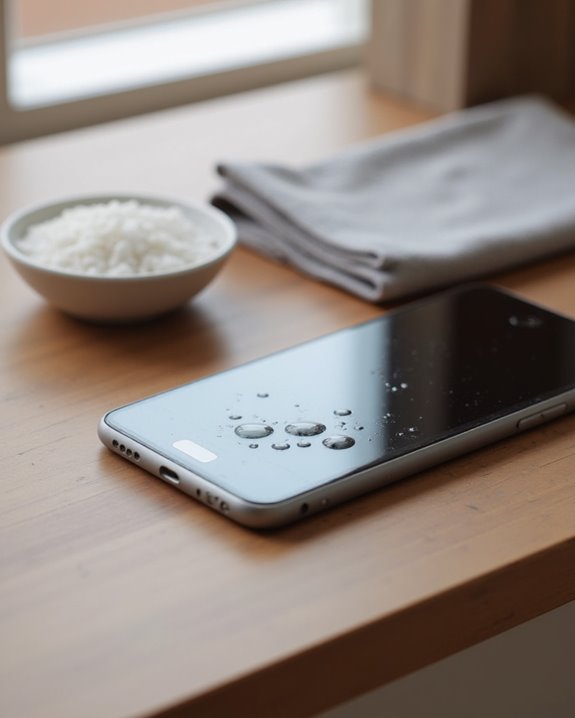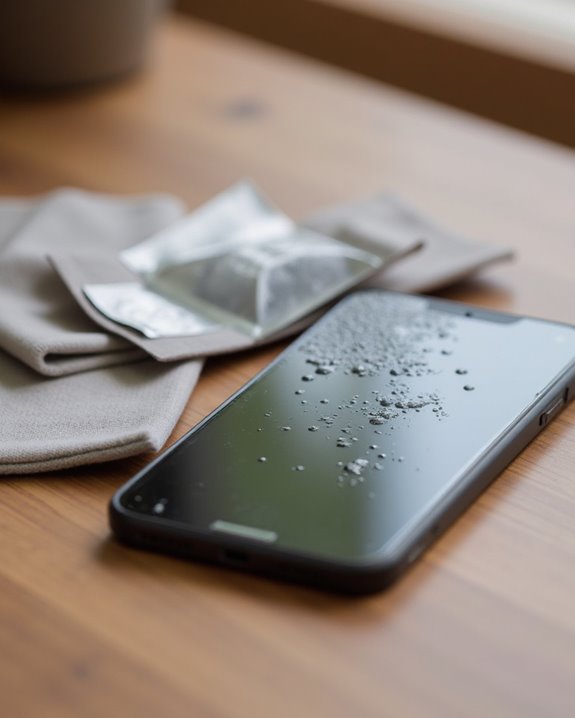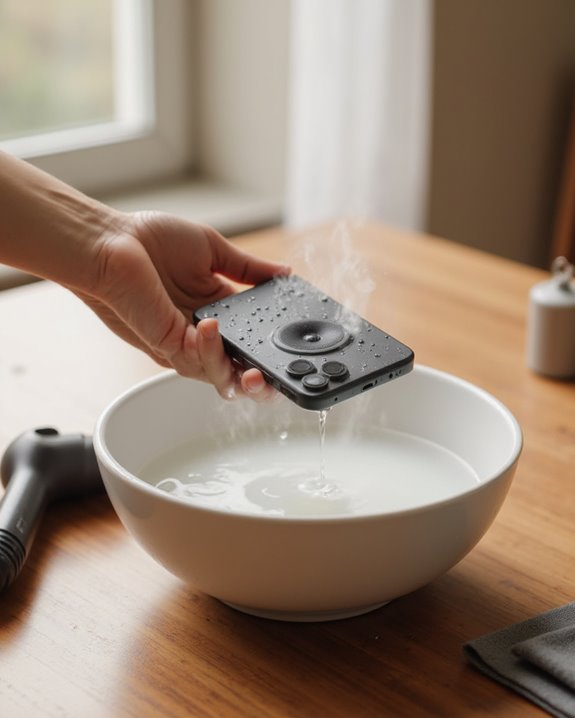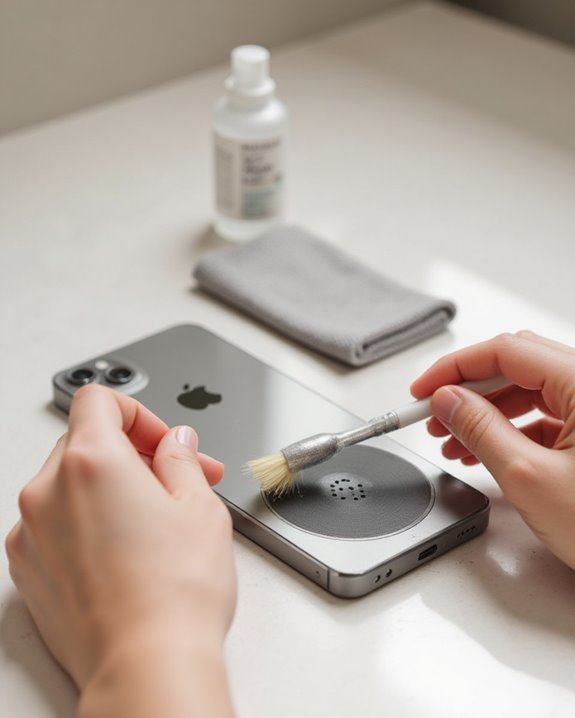To remove water from a phone, immediately power it off to prevent short circuits. Next, remove case, SIM cards, and any detachable components, then wipe exterior surfaces dry. Position the device at a 45-degree angle with ports facing downward to facilitate drainage. Place the phone in a sealed container with silica gel packets (not rice) for 24-48 hours to absorb internal moisture. Allow complete drying before attempting to power on, as premature testing risks permanent damage to internal circuitry.
Key Takeaways
- Power off your phone immediately to prevent short circuits and permanent internal damage.
- Remove case, SIM card, memory card, and removable battery, then gently wipe exterior surfaces dry.
- Position phone at a 45-degree angle with charging port facing downward for 24 hours to drain water.
- Place phone in an airtight container with silica gel packets for 24-48 hours to absorb internal moisture.
- Wait at least 24-48 hours before powering on to ensure complete drying and prevent permanent damage.
Power Off Your Phone Immediately to Prevent Short Circuits
Shutting down your phone immediately after water exposure represents the most essential first step in preventing potential damage to the device. When a phone gets wet, the presence of water can create electrical pathways between components that normally remain isolated, resulting in short circuits that may permanently damage internal components. Users should turn off the phone right away, even if it appears to function normally after being exposed to water.
This critical action applies to all devices, including those marketed as water resistant or waterproof phones, as no device offers complete protection against water intrusion. Powering down prevents electrical current from flowing through the battery and circuitry, greatly reducing the risk of short circuits. Experts consistently emphasize that maintaining the device in a powered-off state maximizes recovery chances.
Remove External Components and Wipe Surface Moisture
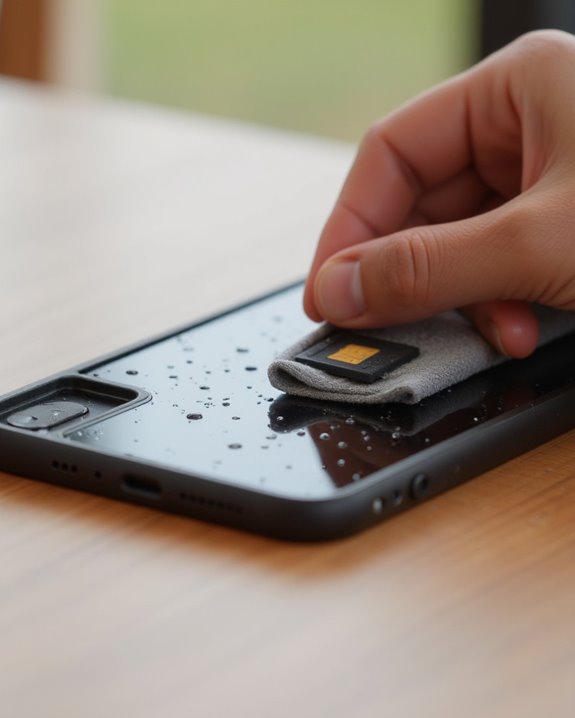
Once the phone is safely powered off, users must immediately begin the careful process of removing external components and eliminating surface moisture. First, remove the phone case to prevent water from becoming trapped between the device and its protective covering. Next, remove the SIM card and memory card from their respective slots, as these small components can be particularly vulnerable to water damage.
For phones with removable batteries, users should carefully remove the battery to prevent potential short circuits and improve airflow to internal components. Using a soft cloth or paper towel, gently dry the exterior of the device, paying special attention to ports, buttons, and speaker openings where excess water tends to accumulate. After wiping away external moisture, position the phone flat on an absorbent surface to facilitate continued evaporation of remaining water.
Position Your Phone for Maximum Water Drainage
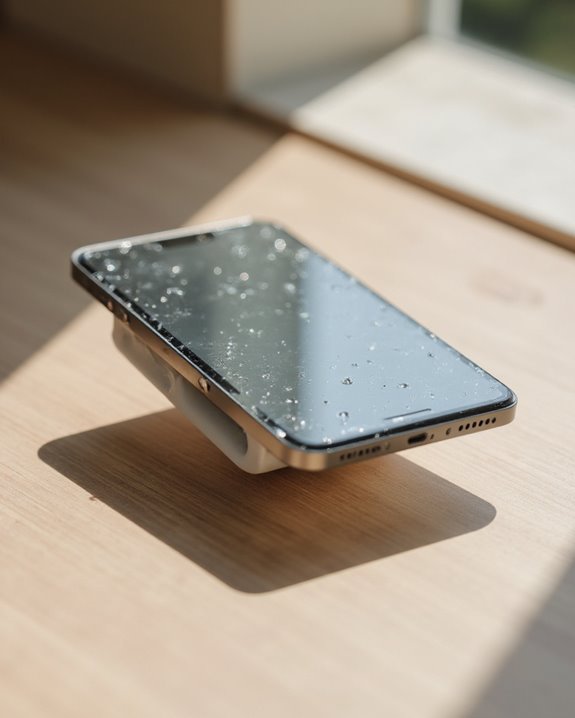
Proper positioning of the wet phone dramatically improves water drainage and minimizes potential damage to internal components. Place the device with the charging port facing downward at approximately a 45-degree angle, allowing gravity to pull moisture out of vulnerable areas like ports and speakers. This orientation facilitates the natural flow of water from internal components to exterior surfaces, where it can evaporate more readily.
The phone should remain in this downward position for at least 24 hours in a well-ventilated area, which enhances airflow and accelerates the drying process. Additionally, position the device on an absorbent surface such as a microfiber cloth or paper towel to capture expelled moisture. This combination of strategic positioning, adequate time, and proper environmental conditions maximizes the chances of successful water removal, greatly reducing the risk of long-term damage to sensitive electronics. In case of salt water exposure, rinse the phone with fresh water to maintain its seals, similar to recommendations for waterproof speakers.
Use Silica Gel Packets for Internal Moisture Absorption
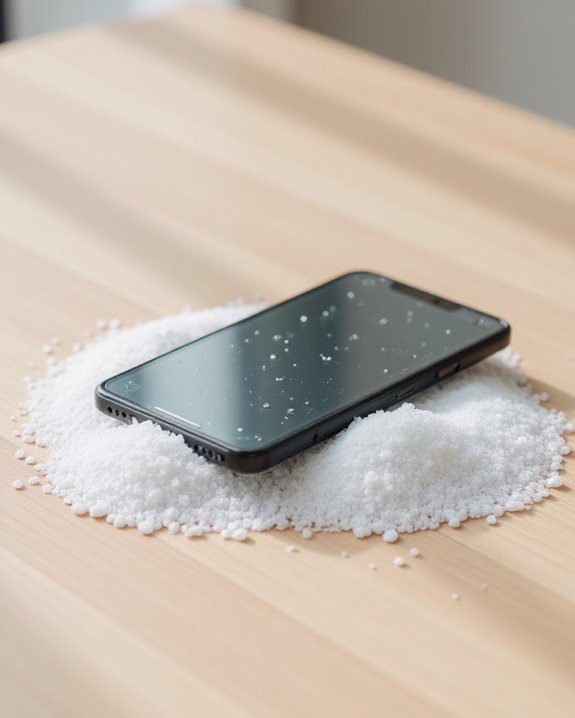
Silica gel packets represent a superior solution for extracting internal moisture from water-damaged phones, outperforming traditional methods like rice in both efficiency and safety. Unlike rice, which can introduce harmful starch particles or dust into device components, silica gel packets focus exclusively on moisture absorption, potentially removing up to 40% of their weight in water from internal circuitry.
To implement this effective method, users should place their phone in an airtight container surrounded by silica gel packets, positioning them both underneath and on top of the device to guarantee thorough moisture extraction from all angles. The drying process requires patience, with ideal results achieved after 24-48 hours in a well-ventilated environment. This technique helps prevent short circuits by thoroughly absorbing internal water, making it greatly more reliable than rice for getting a phone completely dry after water damage.
Allow Complete Drying Before Testing Your Device
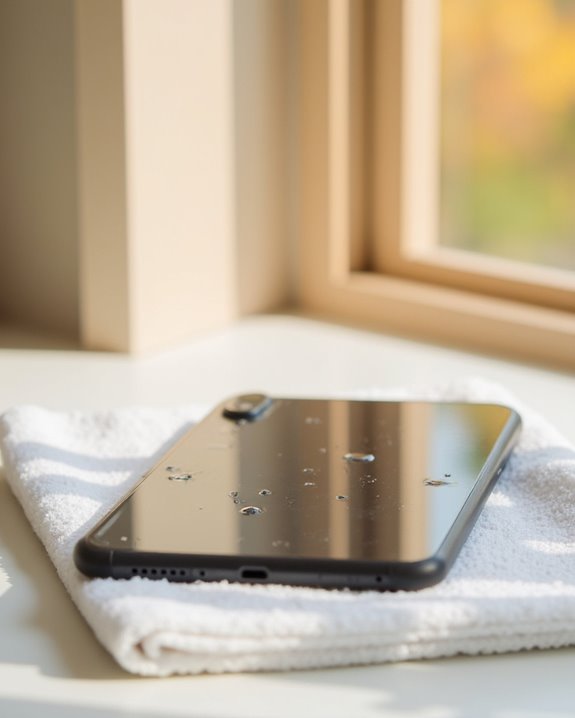
Patience during the complete drying phase represents perhaps the most critical step in recovering a water-damaged phone, requiring users to resist the temptation to power on their devices prematurely. Experts consistently recommend allowing phones to dry completely for a minimum of 24 to 48 hours, with silica gel packets strategically placed around the device to speed up the drying process and absorb internal moisture. For severely water-damaged phones, users should wait a few days to make sure the device has had long enough to air dry thoroughly, particularly in hard-to-reach internal components. During this waiting period, it remains essential to dry the ports and keep the phone in a well-ventilated area. Powering on a device before it has dried completely greatly increases the risk of permanent damage through short circuits. To enhance device protection against water in the future, consider accessories that feature IPX7 rating for better resistance in various environments.
Frequently Asked Questions
How to Get Water Out of Your Phone Quickly?
Quick extraction of water from phones requires immediate power off, gravity tilt, gentle shake method, thorough cloth wipe, and enhanced air circulation. Fan blowing helps evaporation. Professional advice recommends silica gel over alcohol spray or heat application.
How to Remove Water From Phone Screen?
Like a desert sun claiming back its land from a sudden rain, screen drying begins with gentle moisture wiping. Turn off the device, blot droplets with microfiber cloth, and allow water evaporation naturally without heat sources.
What Can I Put My Phone in to Absorb Water?
For water absorption from phones, silica gel packets are most effective. While the rice method is common, proper desiccant bags or absorbent pouches provide superior results. Moisture aids like silica options outperform cloth wraps or other bag alternatives.
How to Fix Black Screen From Water Damage?
To fix a black screen from water damage, diagnostic steps should begin with drying. Component replacement may be necessary after internal inspection. Professional hardware fixes are recommended, though basic software troubleshooting can precede seeking expert advice for screen repair options.

